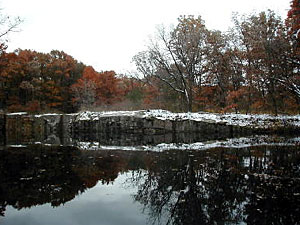|
Audio
Photos
Respond to this story
|
Keeping the prairie pristine
November 21, 2002
Biologists with the Minnesota Department of Natural Resources want to survey the state's sensitive natural areas before they disappear. The DNR's County Biological Survey was created in 1987. Its purpose is to help government officials preserve at risk areas in their communities. The DNR hopes to finish a survey of the entire state within 20 years.
Collegeville, Minn. — Fall is a great time of the year to visit the prairie. The dry, shoulder-high grass parts gracefully as you walk. The summer flowers are gone, but their dark seed heads are still held high.
It's a sight DNR Biologist Mike Lee loves to take in. "Prairie in the fall kind of jumps out at you. The grasses turn this kind of auburn or reddish yellow, brownish tannish hue that very distinctive and they are very attractive on a subtle level," he says.
 | |||
This is the 40-acre Sedan Brook Prairie in western Stearns County. It was never farmed, so it looks and feels the same as it did in pre-settlement times. The ground is soft like a mattress.
Lee says heavy machinery or livestock has never compacted this soil. "This is the sod that was talked about that gave the plows such a hard time to turn over. It's really deep, thick-rooted stuff and this is what was out here."
This piece of property will remain in pristine condition. It will never be farmed or developed.
The DNR's County Biological Survey said this land is one of the finer pieces of prairie in the county, so it became part of the department's or Scientific and Natural Areas -- SNAs.
The DNR also saw the importance in acres of forested land near St. Cloud.
Chuck Wokken is hiking through the 123-acre SNA south of Quarry Park near St. Cloud. The whole area is part of an old granite quarry. And even though its industrial past scarred the landscape, it has a wild feel. This quarry was abandoned 40 years ago. It's reverted to a natural state. The DNR's Biological Survey discovered a rare orchid here.
 | |||
Wokken says that alone made it a great area to preserve. But another good reason is the encroaching development he sees from a high point in the park.
"You used to be able to get up on one of the rock piles and kind of look eastward and there was a cornfield and an open fallow pastureland, and now you look out there and it's solid housing. So that's the future of places like this if they aren't identified for their significance," says Wokken.
It's that sense of urgency that drives the survey. The DNR's Mike Lee says they're running out of time to survey the state's at risk areas.
"A lot of communities, the pressures from the timber industry or from agriculture and mostly development really do lend some urgency to getting out there and finding what we have and making some reasoned decisions about protection or conservation or use while we still have time," says Lee.
But one of the state's strongest tools at preserving land may be in jeopardy. Budget pressures have put a temporary hold on land acquisition by the DNR for Scientific and Natural Areas.
DNR officials hope they get $3 million from the Legislature in 2004. The say they need the cash to continue to preserve sensitive natural areas.
The County Biological Survey is about half done. DNR officials say if all goes well, a survey of every county in Minnesota will be complete in 20 years.
|
News Headlines
|
Related Subjects
|

